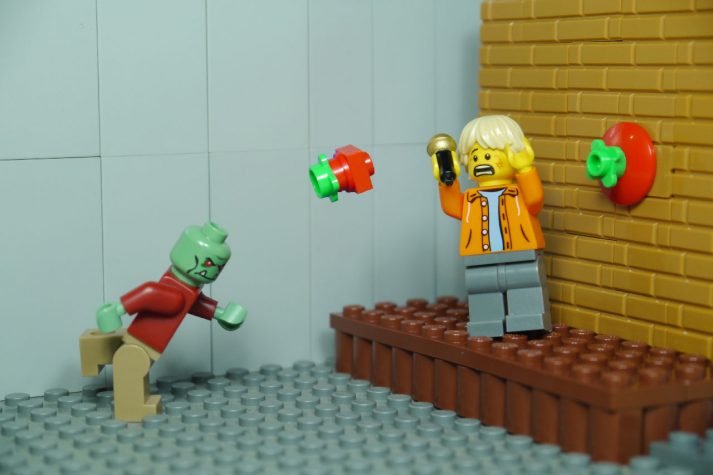3 HIIT Workouts for Beginners: How to Start Interval Training
So you’ve heard amazing things about High Intensity Interval Training (HIIT).
You’re not quite sure what it is, only that people seem to like it and it helps them lose weight. You probably have questions like:
- Is it running?
- Sprinting?
- Why is it so popular?
- What are the positives and negatives I should consider?
- What if I hate running?
If you’re a busy person, you don’t need to be spending hours a day on a treadmill or out jogging around your neighborhood to lose weight. In fact, those hours of running could actually cause a litany of healthy issues if you don’t have great form!

I’ll try to keep things concise so you can get to the root of the real reason why you’re here: “will Interval Training help me lose weight and get in shape?”
Let’s dig in to what interval training is, and how you can use it to give your heart a great workout and kickstart your weight loss regiment.
What is interval training? What is HIIT?

High Intensity Interval Training is following a specific regiment where you vary your speeds and intensity throughout a shorter run/swim/bike/row.
Any cardio, as long as you’re able to vary your speed easily, can be a form of HIIT.
Imagine jogging lightly for three minutes, then pushing yourself hard for a minute by sprinting, and then repeating this cycle 4 more times (usually around 20 total minutes). That’s HIIT.
So what’s the deal? Why is HIIT so hot in the streets right now?
In 2018, HIIT was ranked the number one fitness trend by American College of Sports Medicine[1]. This makes sense to me, because everybody is busy and overwhelmed, so they’re looking for fast results in a minimum amount of time
Which brings us to intense, short workouts that hopefully create the results we’re all after.
(Notice the word “hopefully” there – but I’ll get to that shortly.)
You may be asking, “Steve, just how short and intense are we talking about here? Also your new haircut looks spiffy.”
Thanks! Let’s explore the pros and cons of intervals!
What are the benefits of HIIT?

The 1996 landmark Tabata study demonstrated the benefits of extreme HIIT[2].
Dr. Izumi Tabata, from Japan’s National Institute of Fitness and Sports, was obsessed with interval training. The doctor sought to see exactly what kind of gains were obtained from short, intense, periods of exercise. So he experimented on some Olympic athletes who were hanging around his institute.
The results were fascinating: compared to regular cardio, HIIT had a greater impact on improving both:
- Aerobic increases (endurance)
- Anaerobic increases (power)
“Steve, you’re losing me! What’s that mean?”
Let’s imagine you are trying to increase how long you can run. And you also want to increase how hard you can go.
What would you do to improve?
Most people would answer with “try to run more.” You know, like jogging around the block. They’d start doing this a few times a week to improve their overall running capability.
Not a bad response, but there’s a better answer:
As Tabata demonstrated, the best way to increase aerobic and anaerobic capacity would be to focus instead on bouts of intense effort with sprinting followed by short periods of rest. A HIIT exercise, in other words. The intensity required to do such a thing helps build both endurance and power at the same time.
Plus, it takes less time! The average interval training workout is 20 minutes or less. Tabata was able to demonstrate improvements in his athletes in just four minutes. Incredible.
What’s happening here?
Your heart is a muscle. Intense interval training challenges it by forcing it outside of its comfort zone.
This is a good thing.
If you keep your heart beating at a constant rate, never expanding it outside of its comfort zone, it will never grow stronger. This is not good.
That’s why I support Nasim Taleb’s concept of “antifragility” – by introducing chaos and pushing your muscles outside of their comfort zone, they must adapt and grow more resilient in order to survive!
In other words: progressive overload – the same concept behind building strength.
Since Tabata’s 1996 study, many other trials have shown the benefits of interval training. Such as:
- Weight loss. A study in the Journal of Obesity found participants were able to lose more body fat following a HIIT program compared to regular cardio[3]. This makes sense, because other studies suggest high intensity interval training burns more calories than a “steady state” workout[4]. Revving up your effort requires more out of you, including calories. If you’re interested in HIIT for weight loss, you’re on the right track.
- Lowering blood sugar. Managing blood sugar is really important for health, and not just for diabetics. Those trying to lose fat should be aware of their blood sugar and corresponding insulin levels. The good news for our current discussion? HIIT has been shown to help lower and manage blood sugar levels[5].
- Heart health. Touching on the “antifragile” topic again, HIIT has been shown to help with overall cardiovascular health the same way traditional endurance training does, but at a fraction of the time (almost half)[6].
Sold? Me too. Let’s chat about how to actually do some interval training.
What’s an example of a HIIT workout? How to do interval running

The key to HIIT is being able to go from “easy” to “difficult” All sorts of different exercises can get you there. We can group all workouts into aerobic, bodyweight and resistance.
HIIT is generally associated with running (aerobic), so we’ll devote this section to just that.
However, before we get into running (or any kind of HIIT workout), we need to talk about warming up.
To help prevent injury in any HIIT exercise, warm-up first. It can be as simple as doing some jumping jacks and air punches/kicks. These few minutes will loosen up your muscles, priming them for the intensity we are about to bring.
Also, when you’re done doing HIIT, do some stretching or yoga to cool down. Time to warm-up in reverse. This will help your muscles recover after your intense workout.
Okay, back to running.
Probably the easiest way to experiment with HIIT would be to run.
Here’s how to start with a basic HIIT running workout::
- Go to a park in your neighborhood.
- Warm yourself up with some light jogging, high knees and mobility – leg swings, arm swings, etc.,
- Run at a brisk pace for 30 seconds.
- Need to slow down on the way? No worries. Jog or walk at a slow pace for 2 minutes.
- After your rest, rev up the intensity again. Shoot for another 30 second jog if possible.
- Continue until you get tired or after about ten “push/rest” intervals.
You’ll be surprised how quickly you get better at this, so don’t get disheartened if you find yourself stopping a lot. When beginning, don’t even worry about a timer. Just think about switching intensity.
Also, “running” or “jogging” is subjective. Whatever walking fast means to you is great. Do that for your periods of intensity.
It should be noted, that the entire “Couch to 5K” concept rests on interval training through running. It’s all broken down into “walking,” “jogging” and “running.” If you’re curious, check out our in-depth review of the program here. If want to start interval training, “Couch to 5K” could be a good way to do it.
Are you more of an indoor person?
Consider a treadmill, where it actually sets intervals for you based on your desired difficulty. We’ll be talking about machines a lot more in the next section, but a treadmill is all you need to do a HIIT workout. Experiment with the speed and incline to find a setting that you would consider “intense.” Many machines can be programed to flip between this and an “easy” setting. And you know what that means… boom! It’s built for HIIT
What are other examples of HIIT cardio?

There are a lot of different aerobic exercises for HIIT cardio.
For example, you could jump on a bike.

Biking for HIIT is much like running, but with wheels. Try peddling as hard as you can. Might be difficult to do on an actual street, so a stationary bike would be great for HIIT. Every spin class is based on this idea. Check out SoulCycle, Flywheel, or even your local gym for spin class opportunities. They’re popular for a reason, and you can make a friend or two!
Another important point on bikes: when scientists do research on HIIT, they generally use stationary bikes because of safety and ease of observation and measuring energy output. You probably won’t trip and fall on a stationary bike, no matter how fast you are pedalling. If you’re antsy about doing a HIIT workout because of the potential for injury, the bike might be the way to go.
Don’t have access to a bike?
Let’s chat about some other examples
- Elliptical. If it has a dial for resistance, it can be used for interval training. That’s the name of the game here with the elliptical. For a couple minutes, go on low resistance (0-2 level). Then crank up the resistance for one minute (up to 8-10). Repeat this process for 12 and a half times, which will give you a 20 minute workout (the “half” allows you to stop after a low resistance interval). Everyone’s different, and this includes ellipticals, so adjust as needed.
- Stair Climber. The dial again will help us here. Much like the elliptical, alternate between periods of low intensity for two minutes, then one minute for high intensity. The difference with the climber is the dial will control the speed of the stairs. Be careful.
- Rowing machine. We’ll follow the same strategy here. Start with a two minute warm up. On minute three however, row like you’re being chased by the kraken for a full 60 seconds. Then catch your breath. The rowing machine might be hard to do for a full twenty minutes, since it’s a lot of upper body. Shoot for ten minutes at first.
- Jumping rope. Jumping rope is a full body exercise. Your leg muscles work to jump, your core engages to keep balance, and your arms work to rotate the rope. Also, it’s fun. There’s no dial here, your own body controls the pace of the jump. Follow the same two minute ease, one minute intense as above. Jump rope can also be done with friends!

So far we’ve just been talking about aerobic exercises. Let’s cover our other categories, of bodyweight and resistance.
What other HIIT workouts are there?

Let’s chat about some alternatives to HIIT cardio, because I can already see the emails coming in:
“Steve, this all sounds great. But I hate running!”
Confession: So do I. So I don’t really run.
Here are some bodyweight examples to get going on HIIT:
- Burpees. Stand up, then squat down, kick your legs out, do a push up, bring your legs back in, and explode up into a jump. Try to do 20 repetitions, then rest for two minutes. Repeat this a few times, for 15 minutes. Here’s exactly how to do a burpee:
- Push-ups. For 20 seconds, do as many push ups as possible. Rest. Then do it again. If you’re worried about proper form, check out our full article here. I will mention that I want you to think of your body as a straight line. Focus on tightening this line throughout the whole movement. As demonstrated here:
- Pull-ups. Same idea as above, do pull ups for 20 seconds, then rest. If you can’t do a pull up, we got you covered in this article right over here. Want a video of some nerds walking you through it?
Okay, that’s some bodyweight exercises. Let’s now chat some resistance examples for HIIT:
- Kettlebell swing. For ten minutes, do 20 kettlebell swings on every minute. This will be intense, and worthy of a congratulations when you’re done. Check out our article for everything you’ve ever wanted to know about kettlebells here.
- Battle ropes. If your gym has battle ropes, they’ll be great tool for HIIT. For intensity, the amount of slack in the rope determines the load. The more slack on the rope the tougher, and more intense, the workout. Also, don’t get stuck in just up and down movements. Variation will target different muscles.
- Weightlifting. This would essentially be lifting heavy with fewer reps. More weight equals more intense. The critical piece will be moving from one exercise to another, for example the bench press to the lat bar: we call this circuit training! Might be tricky if you use a public gym and it’s busy, meaning you’ll have to wait your turn. If you can, go early. Beat the rush.
We’ve now covered aerobic, bodyweight and resistance forms of HIIT workouts. Let’s think outside the box though. We can get cray with interval training.
Basketball, tennis, soccer, and frisbee are AMAZING styles of exercise that use interval training (it’s all start and stop!). Run here, catch this and wait for the next round to start. That’s what we’re looking for in a HIIT workout.
So find a buddy and go play!
You can also do circuit training as a form of HIIT. Circuit training is going through a sequence of exercises, or stations, back to back. Push-ups to pull-ups, back to push-ups, only resting briefly from one exercise to another. This training would be perfect to mix it into a HIIT workout, since you can design your circuit to be very intense.
Check out our post for 15 routines to choose form. Plus, there’s a Batman workout hidden in there. You’re welcome.
Now, I understand at this point if you feel overwhelmed. I just threw a lot at you. And you might have a lot of questions: Is HIIT right for me? What should I be eating to prepare for interval training? What days should be rest days?
All good inquires. And we can help tailor a specific response just for you!
We answer questions like this in our 1-on-1 coaching program.
Here’s how it works: we get to learn your goals, lifestyle, challenges, and situation: Kids? An old injury? A job that requires travel? All the above? We got you covered.
We’ll then pair you with a coach from Team Nerd Fitness that fits your personality and situation. They’ll work with you to build custom workouts and nutrition guidance to meet any goal you might have. Unless that goal is ruthless world domination. Use your powers for good, okay?
Want to see if we are a good fit for each other? Click on the button below to schedule a free call. We’d love to talk to you, no matter what!
HIIT for weight loss

My guess is that you’re reading this article because you’re trying to get the most efficient “bang for your buck” when it comes to getting in shape.
And HIIT is a great form of exercise and COULD help with weight loss. I will, however, lower some of these outlandish claims that exist in the media. For example, Time magazine calls HIIT “miraculous” in one article[7]. That’s a little much, even for me, who writes for a living on why you should work out and likes using hyperbole for effect.
Seriously, I’m better at it than ANYBODY ON THE PLANET.
Ahem. Cardio, strength training, and HIIT all have benefits. HIIT deserves praise, but exercise in general deserves praise. As we discussed in our “Cardio vs HIIT vs Weights” post, all three forms of training have their place, and the best one for you is the one you actually do.
And strength training. Always strength training.
So to answer your question, is HIIT the secret and only weapon for weight loss? Na, it’s just great exercise. And exercise is important.
However, I will mention an important point: If you wanna lose body fat, how you eat will be responsible for 80% of your success or failure.
One of the Rules of the NF Rebellion is that “you can’t outrun your fork.”
This means that I don’t care how many intervals you do, it’s not gonna help you lose weight if you don’t also fix your nutrition. You can read our Beginner’s Guide to Nutrition if you want more information.
If you want to download our free 10-level Nutrition Guide to help you fix your diet starting today, you can do so by signing up in the box below:
- Follow our 10-level nutrition system at your own pace
- What you need to know about weight loss and healthy eating
- 3 Simple rules we follow every day to stay on target
Getting started with interval training

When it’s time to advance your high intensity interval training, think about the following:
- Frequency. This would be the number of intervals in your workout.
- Intensity. How hard are you going in each interval.
- Time. How long are your intervals, resting periods, etc.
Maybe you start out doing three intervals of intense running. Once it becomes routine, bring it up to four intervals.
Maybe you crank the resistance on your stationary bike to “8” during your intense interval. When it becomes normal, bring it up to “10.”
Maybe you do pull ups for 20 seconds. When you’ve got a good handle on that, aim for 30 seconds.
This mindset will keep you advancing in interval training.
What to progress in any category? Consistency is the name of the game. Even just doing a HIIT workout once a week will help you progress in all three categories.
Mistakes to avoid when doing high intensity interval training

There’s a lot to consider when embarking on a HIIT practice. No matter which routine you end up starting with, make sure you think about the following:
- Ease into it. Despite the “intense,” go ahead and start slow. As the saying goes, “you must walk before you can run.” The importance is building a HIIT practice. If you need to go “less intense” before progressing to “intense,” that’s fine. It’ll help build your aerobic capabilities (endurance), which will be important when working on intensity.
- Keep proper form. Doing your movements correctly will help prevent injury. This is even more important in your later intervals, where you may be exhausted and tired. If you find yourself breaking form, go ahead and slow down. Intense isn’t worth an injury.
- Get rest. Our bodies actually build muscle while we are resting. So take some “off days” from your HIIT practice. Want to stay active on these days? Go for a walk!
Take it easy, focus on your form, and make sure to prioritize rest.
HIIT Timer Recommendations

HIIT centers on doing intervals. One moment it’s intense, the next you’re onto a short rest break.
A good way to know when it’s time to go from one sequence to the next is a timer. A loud “beep” can tell you when it’s okay to catch your breath or when you have to kick it in gear.
- J&J Official Seven Minute Workout. This free app from Johnson & Johnson is actually really awesome. It has premade workouts you can choose form based on your fitness level, or tweak them to make it your own.
- Runtastic. Don’t let the name fool you, this free app is for more than just running. You can customize for many different interval workouts, depending on what exercise you go with. And the interface looks slick.
- Seconds. It’s free and customizable to any form of HIIT. It can also integrate with your music, which is pretty sweet.
- Seven. If you’re new to HIIT, Seven would be a good app for you. It’s free, plus it has illustrations for exercises. You also get to customise your own virtual personal trainer, which may be the future of fitness. The bots are coming…
- Sworkit. First off, it’s a clever name (taken from “Simply Work It.”) Second, it’s free. Third, it can display your workout, goals, and calories burned. I like it.
Also, we need to talk about interval times. Most of the apps referenced are completely customizable. For example, you can change the intense interval from 120 seconds to 90 seconds. This is critical, because it’s up to you to decide how long you can do intense vs. rest.
Generally, folks recommend one minute of intensity and then two for rest when doing HIIT. However, this all depends on the individual, and exercises performed. Burpees are tougher to do than jumping over a rope. So feel free to make changes like 30 seconds of intensity and three minutes of rest. Make it your own.
Whatever way you chose to do HIIT, is fine, as long as you actually do it. The benefits of HIIT kick in when going HARD for you. In other words, you don’t have to be an Olympic athlete to get the benefits of HIIT[7]. Your light jog down the street works.
As we discussed, if you’re consistent, you’ll improve. So don’t stress on where you have to start. For now, download an app and get going.
Okay, I think I’ve covered everything. You now know about HIIT, have a bunch of workouts to choose from, and apps to help with timing! Let’s go!
I hate multiple choice! Pick a HIIT workout for me!

Fine. Let’s power walk!
- Warm-up. For three minutes, walk at a easy pace.
- Intervals. Let’s do seven intervals, two minutes each. For the first 60 seconds, power walk, like you’re trying to beat someone to the front of the line at Starbucks. For the next 60 seconds, just walk. Repeat six more times.
- Cool down. You can do some more light walking, or a little bit of stretching here would be great.
Total time: 20 minutes.
I want to stress, that you can do just about any exercise in exchange for this routine. Just minus “power walk” and add “push-ups.” It’ll still be a great HIIT workout.
“But Steve, that’s still multiple choice!”
Right, right… sorry. Stick to power walking for now.
Start now

Let’s shock your heart today!
No jumper cables, let’s do interval training.
If you got through this whole article, you need to actually try it. That’s the point.
Do our power walking routine above. It’s a great place to start. Don’t stress if it seems too simple. Remember, our goal at this stage is comfort. We can work on “whoa, that was intense” later.
Keep it up and your heart rate will be roaring before you know it. If you’d rather sprint, let’s do it! There’s a zillion ways to do HIIT. Just don’t let the options paralyze you. Pick one, anyone, and get to it.
Interval training, in any form, is a solid fitness choice and a great practice to have in the workout arsenal.
Let’s go!
-Steve
PS: As a reminder, if you want help on your fitness journey, we can help. We have our 1-on-1 Coaching program that will help you transform. If you’re looking to level up your life (and you are if you read this whole article), then an accountability partner would be one of the best tools to utilize. Click here to learn more.
###
All photo credits can be found in this footnote[8].
from Nerd Fitness https://ift.tt/2mnLWQW

0 comments:
Post a Comment